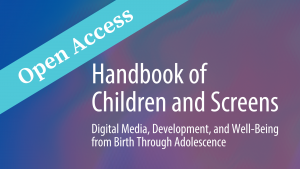
Early childhood is a critical period for brain and relationship development, and young children (ages 0-5) respond to and process stimuli in unique ways from adults and older children. How does digital media use affect early child development and mental health in regards to emotion regulation, sensory regulation, and the ability to relate to others? How should care providers approach technology use in order to protect and promote mental health in very young children?
Children and Screens hosted the “Ask The Experts” webinar “Early Childhood Mental Health and Digital Media” on Wednesday, May 1, 2024. Moderated by noted early childhood expert and our Chief Science Officer Dimitri Christakis, MD, MPH, a panel of clinicians, child psychologists, psychiatrists, and developmentalists explored the research on digital media’s impacts on young child sensory and emotional regulation, discussed how these interact with the development of mental health, and provided insights on best practices to promote well-being in the early childhood years.
Speakers
-
Dimitri Christakis, MD, MPH
Director of the Center for Child Health, Behavior and Development, Seattle Children’s Research Institute; Chief Science Officer, Children and ScreensModerator
-
Gilbert Foley, EdD
Consulting Clinical Psychologist, New York Center for Child Development; Clinical Co- Director, NYC Early Childhood Mental Health Training and Technical Assistance Center
-
Stephanie Jones, PhD
Gerald S. Lesser Professor of Child Development and Education, Harvard Graduate School of Education
-
Lisa Linder, PhD
Licensed Clinical Psychologist, Professor of Child and Family Development, San Diego State University
-
Joan Luby, MD
Samuel and Mae S. Ludwig Professor of Child Psychiatry, Washington University School of Medicine
Resources Mentioned During the Webinar
- Media use by children younger than 2 years (Scholarly Article)
- Factors in the Optimization of Early Childhood Neurodevelopment. (Figure)
- Common Sense Media Ratings (Organization Website)
- EASEL Lab Resources (Organization Website)
- The Mediatrician's Guide: A Joyful Approach to Raising Healthy, Smart, Kind Kids in a Screen-Saturated World (Book)
0:12 Introduction
Kris Perry, MSW, Executive Director of Children and Screens: Institute of Digital Media and Child Development, introduces the webinar and panel moderator, Dr. Dimitri Christakis, acclaimed pediatrician and scientist who examines the developmental consequences of digital media. Dr. Christakis briefly discusses his background and the importance of early childhood as a developmental period.
4:17 Joan Luby, MD
Joan Luby, MD, Samuel and Mae S. Ludwig Professor of Child Psychiatry at Washington University School of Medicine, discusses the critical social and emotional tasks children need early in life for healthy development. She stresses the importance of face-to-face interaction with attentive caregivers and the idea that screen time displaces other important developmental experiences. Dr. Luby lists the negative effects of early childhood screen exposure and explains the sensitive periods of early childhood development.
12:24 Gilbert Foley, EdD
Gilbert Foley, EdD, Consulting Clinical Psychologist at New York Center for Child Development, explores how screens and their contents interfere with sensory and emotional regulation. He describes how screen use in early childhood can undermine creativity, emotional stability, and executive function. Dr. Foley emphasizes the importance of rough and tumble play, especially in early childhood, and advocates for children to experience the full range of appropriate sensory and social experiences.
22:35 Lisa Linder, PhD
Lisa Linder, PhD, Licensed Clinical Psychologist and Professor of Child and Family Development at San Diego State University, discusses the role of relational health in the development of self-regulation across early childhood. She stresses the importance of caregiver interaction to neurological development, and how screen time may interfere with healthy coping and attachment. Dr. Linder also provides some context for parents, describing how mindful use of technology can play an assistive role in everyday life without undermining development.
35:07 Stephanie Jones, PhD
Stephanie Jones, PhD, Gerald S. Lesser Professor of Child Development and Education at Harvard Graduate School of Education, shares her research and insights regarding the development of self-regulation and executive function as they relate to screen time. She explains how these foundational skills are best nurtured, and also discusses the broader implications of early screen use in children in terms of stress management and emotion regulation. Dr. Jones emphasizes the role of neuroplasticity in maintaining flexibility into adulthood.
49:55 Q&A
Dr. Christakis brings the panelists back together to answer a series of questions from the live audience. Topics include the limits of electronic and digital toys, the importance of the input to output ratio when considering screen time, and the criticality of answering the “why” question behind screen use. Panelists also explore tech use in early education settings, the challenges faced by under-resourced families, and how to think critically about the time and quality of device use throughout early childhood. Each panelist is then invited to share one final parting piece of wisdom with the audience.
[Kris Perry]: Hello and welcome to today’s Ask the Experts Webinar, “Early Childhood Mental Health and Digital Media.” I am Kris Perry, Executive Director of Children and Screens: Institute of Digital Media and Child Development. Today is the start of Mental Health Awareness Month and what better way to kick off the month than by learning about the foundations of mental health in early childhood? I’m sure we are all aware of the mental health epidemic facing youth around the world and increasingly we are dissecting the role of social media and digital devices in teens’ lives. However, we believe it’s time to pay more attention to the early years of childhood and the critical skills that are developing during this period that lay a framework for wellbeing throughout our lives. To unpack the ins and outs of mental health during early childhood and the impacts of technology used both directly by children and by those who provide care, we have brought together an esteemed group of child developmental lists researchers, psychologists and psychiatrists. Now, I would like to introduce you to today’s moderator, Dr. Dimitri Christakis. In addition to being the chief Science Officer for Children and Screens, Dimitri is the director of the Center for Child Health Behavior and Development at Seattle’s Children’s Research Institute. George Adkins, professor of pediatrics at the University of Washington, editor in chief of JAMA Pediatrics and Chief Health Officer of the Special Olympics. He has devoted his career to investigating how early experiences impact children and helping parents improve their children’s early learning environments, authoring over 250 original articles and a book and book chapters, a textbook of Pediatrics and the Elephant in the Living Room: Make Television Work For Your Kids. Welcome, Dimitri.
[Dimitri Christakis]: Thanks, Kris. I want to welcome all of you as well to this extremely important session. As Kris said, my passion is early childhood and which is why this particular topic is near and dear to my heart. I also am one of the lead authors of the American Academy of Pediatrics recommendations regarding screens in young minds. And I’m guessing those recommendations might come up today. To provide a little bit of context for those of you that already know it, when I was a child, which is to say in 1970, the average age at which children began watching television, which is the predominant medium back then, was four years of age. And today the average age is closer to four months of age. So we’ve really shifted dramatically the age at which children begin to interact with screen media. And it’s not just the age, it’s the amount of time they spent with it.Based on data that we’ve collected, others collected, the typical preschool child spends as much as 30% of their waking hours in front of a screen of some kind. And given how incredibly important early childhood is to laying the foundation of content for cognitive, social, emotional and physical health, it does beg the question of “What is the impact of all of that screen time, both in terms of the quantity and the content?” It’s extremely important. I think that is reflected by the fact that this is our record number of attendees signed up for this. I think over 1300 of you signed up. So there’s that much interest in the topic. And as Kris said, we’ve assembled an incredible panel to help unpack it, and we will have each panelist briefly talk about their area of expertise and give some practical advice about their recommendations for screens with young children. And I promise you will have lots of time at the end for your questions. My job as moderator’s not to take up too much time so I will be quiet and serve in the role of moderating by beginning by introducing our first panelist, and our first esteemed panelist is Dr. Joan Luby. She is the Samuel and Mae S. Ludwig Professor of child psychiatry at the Washington University School of Medicine, where she founded and leads the early emotional development program. For 30 years, Dr. Luby has specialized in infinite preschool psychiatry with a focus on early childhood affective psychopathology and emotional development. Dr. Luby has published 300 papers and has been awarded numerous honors, including membership in the National Academy of Medicine, the Brain and Behavior Foundation, Rune Award, and the American Psychiatric Association Ittelson Award. Welcome, Joan. Please share your screen and share some wisdom with us.
[Joan Luby]: Thank you. So what I want to express in my 7 minutes to this group is the idea that there are really critical social and emotional developmental tasks that children need to achieve in the first few years of life. And these tasks really require in-person live interactions with human caregivers. And they are things that screens cannot provide and the screens will likely interfere with. So one is learning to identify and label emotions in themselves and others and to accurately perceive emotions in others is a critical, foundational emotional skill essential to later mental health. The other: learning to regulate intense emotions. This is best done through coagulation with a caregiver, learning empathy, helping, and other prosocial behaviors. Again, these are things that can only be achieved in early childhood in the presence of other human beings, modeling these types of behaviors. Along this line as social problem solving.
Another key feature that we’ve more recently been learning about is the importance of developing regular circadian rhythms and sleep. We now know that this is actually a fundamental need for healthy brain development. And screen use may very much interfere with this. And I can talk a little bit more about that later. The other key issue here, and this has been well known for many, many years and widely agreed upon by child developmental researchers is the fundamental importance of the caregiver child relationship, particularly in the first several years of life. The child needs the live, nurturing, attentive caregiver to meet their basic safety. Security and survival needs, to validate their developing identity, to develop secure attachments to promote stimulation and positive development, and to promote organization, rhythms and regularity in their life. This really is an under-recognized, vital sign that I argue, should really be something that all primary care providers are very much monitoring. The other reason why I think early childhood is so tremendously important, as Dimitri just alluded to, is that it does represent a sensitive period in brain development. So therefore it is a closing window of opportunity to promote positive development or a window during which children are much more vulnerable to adversities and negative influences in the environment. A sensitive period is a period of heightened brain plasticity when experiences and exposures actually powerfully shape and influence brain development both structurally and functionally. They represent closing windows of opportunity or vulnerability. And really the brain at this point is like a sponge. It’s very receptive to be informed or changed by experiences. So one can imagine that a screen experience could have a tremendous influence on the sensitive period of the developing brain. So negative potential negative effects of early screen exposure. Perhaps most important is the content of media, in the research that we’ve done and many others have done. Exposure to violence early in life is a robust predictor of negative outcomes. And even if children are not initially exposed to violence on screens, what we find are that algorithms are written so that children can rapidly become exposed to violent content, even if that’s not what the parent thinks they’re setting the child up for. Of course, there’s also the lack of exposure to live human interaction, something that is fundamentally important to the healthy social emotional development of the young child. The other issue that we know about screens and that empirical research has validated, is that children who engage with screens, that’s time that they are not spending with their primary caregiver or with live interactions with other humans. And screens are not a substitute for this. And then there’s the issue, too, of the exposure to the blue light of the screen. Many parents might use screens to help their child go to sleep. Very, very counterproductive because this actually interrupts and disturbs circadian rhythm. So just to use a cooking metaphor that I found very useful, of course, if we’re cooking and we’re marinating chicken, for example, we can really, really determine what it’s going to taste like at the outcome. We can either put it in lemon or garlic, or you could use chipotle peppers. And what I’m arguing is that the human brain is fundamentally similar to that. During a sensitive period, the human brain is exposed to its environment and therefore the outcome and the later way the child behaves, sees the world, perceives the world is very much influenced by the exposures in the first three years of life. So in that sense, the screen provides a certain form of marinade or exposure that may not be what you want your young child to be experiencing.
[Dimitri Christakis]: Thank you so much, Joan. I love the cooking metaphor of marinating the brain. I wonder if you could talk a little bit about – could you talk about the critical importance for developing social emotional regulation? What about the emerging literature suggests that children actually start to use screens as an emotional regulator? You know, I’m struck by the fact that – I’m no longer a practicing pediatrician, but I hear from my pediatrician colleagues that, you know, when their toddlers get shots now, the first thing that the caregiver does is hand the child the phone rather than, you know, pick the child up and hug them or teach them some some method of self-soothing which shows just how reliant children have become on these devices as a means of emotional regulation? Do you have any thoughts on that? And what the long term implications might be?
[Joan Luby]: I do. I mean, this is something that I think is really, really alarming. Of course, we see it when we’re out in the public, out in restaurants. Parents are using screens as an external emotion regulator. But the problem is a screen does not suffice to do that in an adequate way.
What it essentially does is sort of provides a distraction from an emotional experience. And what children instead need to do is they need to learn how to process and regulate an emotion which is not something a screen is going to provide. That’s something that requires another human being. So if the child doesn’t get exposure to that skill, they will be very impaired in their ability to actually experience and process emotions. And they will essentially be emotionally delayed and at risk for many other poor emotional outcomes.
[Dimitri Christakis]: Right. I agree. Thank you so much. Our next speaker is Dr. Gilbert Foley, who serves as consulting clinical psychologist at the New York Center for Child Development in New York City and clinical co-director of the New York City Early Childhood Mental Health Training and Technical Assistance Center. He has many additional roles in service to the field of infant mental health, and his contributions have been recognized by a number of honors. He is also the author of three books, including the recent linking Sensory Integration and Mental Health, Nurturing Self-regulation in Infants and Young Children released by National 0 to 3. Gilbert, Please share your screen and share your wisdom with us.
[Gilbert Foley]: Welcome, everyone. Thank you for that nice introduction and welcome.
I want to begin by saying, you know, we live in a sensory bath and I use the word remember because we’re probably not aware of all the sensory information we’re receiving all the time. And that really is a big part of what sensory regulation is about, that we can filter out a lot of that information around us. If we couldn’t, we would probably be confounded in our ability to solve goal directed tasks. So the regulation of sensation of our basic physiological arousal and as Dr. Luby just said, our emotions. Now, emotion regulation is, early on, largely contributed to by the ability to regulate sensation and be aware of the messages that we’re getting through our muscles and joints and our body and the internal organs. So screens work. We know that if kids are dysregulated or when we give them the screen, they’re focused, they’re organized. But it’s – there’s a big price to pay for it. And it really imposes a kind of deprivation. And when looking at the literature, it has some very serious impact. We know that high users tend to show less curiosity, self-control or emotional stability. Children rated as having persistent self-regulation problems were more likely to consume media at age 2. Screen time at age two is negatively associated with the development of executive functions in toddlers at 2 to 3, and that’s the top down ability to put on the brakes. Screen time at four years of age was directly-This was a large study of over 400 children followed longitudinally screen time at four years of age-was directly, positively and significantly associated with dysregulation and an ability to calm, to organize, to focus and respond to sensory information and negatively associated with mathematics and literacy in grades eight and eight and at eight years of age. So we know this early on casts a very shadow. Exposing babies and toddlers to TV and other digital media has been linked to a heightened risk for what we know as sensory processing disorders. And here is the direct link, I think, between overuse of screen time and the whole ability to regulate, organize and filter out sensory information, children’s emotion regulation challenges have been partially accounted for, keeping the link of screen exposure and behavioral problems. It’s also been linked to ADHD and high screen use can actually wear out the brain’s pleasure centers. So what do we recommend? Limit screen use to the parameters recommended by the American Academy of Pediatric. And if you are using screens, join your child in screen use by creating joint attention and opportunities for interaction and two way communication, and ample amounts of tactile information. Holding your child, touching your child, is so, so critically important since the skin is the largest organ of the body. Afford your child ample opportunities to engage in traditional play. And they can be simple materials such as blocks, water, paint and clay. Provide ample opportunities for rigorous muscularity play, rough and tumble play, getting lots of information through the muscles and the joints and the balance system. And as Dr. Luby also pointed out, it’s so important as parents to serve as a co-regulator for your child. They can’t do it all themselves. Early on they need you to help with structure, with touch, and then eventually with language.
[Dimitri Christakis]: Terrific. Terrific. Very practical recommendations. I’m curious what your thoughts are. I mean, you talked a lot about sort of eliminating screens or minimizing screens. What about this concept of what we call background television, which is to say that televisions that are screens, I should say, not necessarily televisions, I’m dating myself. They’re on in the background, not necessarily intended for the child to have thoughts on the implications of that.
[Gilbert Foley]: I do. You know, it’s a little bit like secondhand smoke, isn’t it? If you’re getting all that on stimuli, light and sound, that I think is very distracting to the child. And obviously there are some children who you know can filter it out. But I think in very young children that adds another hurdle for them to jump. And again, there has been this relationship between the screen time. This was direct screen time. But I think even the secondary screen time and ADHD, which is an attentional disorder. So I think it’s really kind of upping the ante for the child to be able to process all that added ambient information and thinking and be able to regulate themselves.
[Dimitri Christakis]: What about since you brought up the issue of ADHD? What about it? I’ll invite Joan to comment on this, too. What about what about children that are neurodiverse, that is to say that they are on the autism spectrum or that they have ADHD. I’m sure we’ll get questions about this from the audience as I always get them. It’s not uncommon to hear parents say that for their child, the screen is the only thing that calms them. The only thing they can attend to, the only thing that helps them calm down, and then in fact, reducing screens, you know, leads to two outbursts. GILBERT And then, Joan, if you have any thoughts on it
[Gilbert Foley]: Well, I do see a lot of children on the spectrum. I still am practicing and we know about 82% of children on the spectrum do at least have one kind of sensory atypicality. So they’re already really at risk for having difficulties with sensory regulation. Yes, Sometimes the screen can be kind of an immediate way to get them organized. Of course, it’s novel. It’s interesting. It may have animation. The problem is that sensory integration is a multi sensory process. And when you’re using a screen, you’re primarily using visual and auditory systems, but it’s not using the touch system, it’s not using the balance system, it’s not using the messages we get through muscles and joints. So it really is important that these children get a lot of help, largely, I think, through occupational therapy where we’re really helping them to gain greater regulation through a multisensory approach.
[Dimitri Christakis]: Any thoughts, Joan? Thanks. Gilbert
[Joan Luby]: Yeah, I really agree with Gilbert. I mean, I do think that sometimes screens can be very useful for very, you know, kids with severe autism who are older. I still don’t think it’s a good modality to be using birth to age three when other skills could be developed.
[Dimitri Christakis]: Joan, you can share your screen again. We’re ahead of schedule. You didn’t finish your last slide and I think you had some tips there. Do you want to bring those up now? Can you do that?
[Joan Luby]: Sure. So my last slide was really just sort of presenting a schema where it’s sort of looking at how we can use sensitive periods to direct how we intervene with children. The idea that during sensitive periods it may be really important to protect children from adversity and in the area of screen use, that’s where I would argue it’s very important not to use screens as a replacement for human interaction and human contact. Later in life, I do think screens with the appropriate content, you know, can provide some help and assistance in positive developmental ways. But again, it has to do with proportion and it has to do with the content. But this really just looks at how sensitive periods can inform how we nurture children and protect them at particular times in life.
[Dimitri Christakis]: So I guess your point there being that even in the scenario where screens were, a particular screen, particular app was harmless, let’s say, or reported to have some benefits, the simple displacement of other essential interactions and activities on balance proposes risks for children. Is that the point there?
[Joan Luby]: Exactly. Exactly. I really think it’s almost it interferes with the humanization process. I would literally go so far as to say that.
[Dimitri Christakis]: Terrific.
[Gilbert Foley]: Yeah, I would, I would add to that and say, you know, it really becomes a form of deprivation because you’re not experiencing the full range of sensory and human experiences. So we don’t think so much today about deprivation because I think we live in an overstimulating world, but by being so overstimulating, what aren’t we getting?
What is it keeping us from doing?
[Dimitri Christakis]: Great, I mean, it’s ironic, of course, because I’m hoping parents are getting this message. I, I hear from so many of them, they marvel at their child’s facility with, you know, at navigating it like it’s a sign that they’re a budding tech giant. I mean, the paradox is that they, I think, perhaps understandably think that their facility with the screens represents advanced development as opposed to potentially delayed development. Okay. Let me introduce our next speaker. There’s so much to talk about and we haven’t even gotten to the questions. Doctor Lisa Linder is a licensed clinical psychologist and associate professor of child and family development at San Diego State University. She is executive director of the Healthy Early Years Clinic, providing specialized therapeutic services to children and families prenatal to eight years old. And she is the co-director of the Center for Excellence in Early Development, a transdisciplinary research based training center with a holistic approach to supporting early childhood development, mental health and education. Hello, Lisa. Please share your screen and share your wisdom with us.
[Lisa Linder]: Hey, everyone. I’m going to talk about balancing media with critical developmental objectives for relational health. And this all starts as many of our previous folks have said in early relationships. So early caregiving relationships and interactions serve to lay the foundation for development and learning, especially in terms of social and relational development. So joint or shared attention, which this dad is doing a wonderful job of exampling for us here, serves as a plug into the child’s neural development, and it allows the parent to plug in to the child’s cues and sync their responses to the child’s needs. If you’re a tech person, you can maybe consider this similar to downloading the operating system for a future social relationships. And so when we plug in through shared attention with our child, it facilitates a back and forth exchange in which we model for and coach the child to learn to engage within our culture. Over time, they move from learner to partner, and this lays the foundation for communication and building a lot of the critical social capacities. When we respond sensitively, when we plug in in the right place at the right time to a dysregulated child, we’re using co-regulation that our first speaker spoke about as well. We’re overlaying our nervous system, plugging it into theirs to calm their nervous system. And this over time develops the neural pathways to calming strategies. Over time of walking this path with them hand in hand, over and over it creates that well-worn neural pathway that they can begin to walk on their own, and that’s the pathway to self-regulation. So what happens when we replace grown ups with media? We disconnect the plug, right? Download incomplete. With media devices everywhere in all environments, there’s less and less opportunity to plug into our children and engage in these interactions that provide critical neurological scaffolding. When we provide media as a tool to calm a dysregulated child instead of ourselves, we’re restricting their capacity to cope with emotion. So media, I think, as it was mentioned before, as a calming device, is a distraction from strong emotions. It’s an escape from the problem. And while this is a valid coping mechanism, right, sometimes it’s okay to put the pause on emotion, right, and come back to it at another time. This cannot be our only coping mechanism. True social emotional competence requires us to be able to sit with strong emotion and be able to think and problem solve and work collaboratively. But being 100% plugged into our children all of the time is impossible and it’s unreasonable. And there’s a certain tension in our culture, in our society, between being the best parent and completing the tasks of daily living as if these are mutually exclusive things. And they’re not. But that’s a workshop for another day. Media comes into this conversation because it’s an opportunity for parents to get the tasks of living done without the complication of managing the chaotic childhood experiences right? And it’s often villainized as the way that parents avoid the hard parts of parenting. And I’m going to maybe say something that might be somewhat controversial and suggests that media may not be the villain of the story, but rather a tool that has a certain time, place and way in which it should be used to be safe and effectively like a band saw or a hammer, right? We shouldn’t use them all the time for every job, but there’s a time and a place where it could be useful to get the job done. So I’m going to talk about four, maybe how to’s used to integrate media as a tool while also continuing to hold in mind imbalanced relational health. And the first one. This is just the tip of the iceberg, right? I cannot go into excessive detail in such a short amount of time, so I hope this maybe lays the foundation for you to kind of go out and research and maybe know where to begin. So people often want a list. They give me, tell me what’s good and I’ll have my kid watch that. And then honestly, this varies by your child and your culture in your family, right? So be thinking about representation if you’re gonna, right? We can’t, I don’t think we can ask parents to have zero media all the time. Even in early childhood. And so let’s make choices when you are going to use media that are representative of things that are important to your family and expose your child to a variety of like STEM pathways and careers. And then a technique I encourage parents when trying to make these decisions is to triangulate information, right? Use suitability ratings along with our friends ratings from Common Sense Media. They’ve done a lot of work in this area to give you some ideas of what’s what the content is, preview the content whenever possible, and if not, if there’s not time, then make sure your kiddos are nearby you right when you’re watching something or engaging in new media so you can jump in and course correct if it’s like, Whoa, that was not what I expected. And I never say never except for this. Never, never have unmonitored access to media content. This is so common and it shows up in our clinic all the time. Would you give your child unmonitored access to a shed full of power tools? No, no, we would not do that because tools like media are powerful and in the wrong hands, Dangerous, right? Same principle applies here. The next line is predictability, right? We’ve checked the box on quality. Now, I think, you know, there’s this nagging parents always like they’re just always nagging me for media. One thing that can help with this is predictability, right? Children aren’t able at this age to effectively manage or gauge time, and they do really well with clear and consistent boundaries.So what I suggest is try to plan a Showtime or a media time that’s every day at the same time for the same amount of time, write, give or take about 15 minutes because holy crap, my casserole is not done cooking, right? Those things are going to happen. But try to contain it, right? Contain it and then always, always give a transitional warning. Plug into your child. Hey, how many? Okay, you got your eyes. Now it’s time, right? We’re going to be 5 minutes. Okay? More media, and then we’re going to go to dinner. Okay, Five more minutes. I don’t want any yelling or screaming or we’re not going to get media tomorrow. Right. Five more minutes and then you go and you give that transition 5 minutes later. So the next thing to be thinking about is balance, right? And when I’m thinking about balance and thinking about the balance of input to output, a lot of our folks have talked about the effects that media have long term, right? So let’s think about that. Let’s think about how when we’re looking at a screen and we’re having a show, it’s input, input, input, input input, and we’re not actually exercising our brain right. So it’s critically important that we make time for creative expression, exploration and even boredom, right? Boredom is actually really great for creativity and cognition. So cognition and creativity both are going to flourish in a variety of experiences. So find balance, right? This is crucial. And then we also want to find balance between interaction versus distraction. Right. I’m in the car. I’ve been in the car for an hour and my kids are starting to melt down and I’m on the freeway and I can’t pull over and I can’t use my body to calm you. Maybe this is a time to push the pause button like we talked about early, and that’s okay to give them media. But then I’m at their restaurant, they’re starting to get antsy in their pantsies.And this is maybe now the time where I need to use myself, right? I’m going to use myself. I’m going to walk you around, I’m going to cuddle you. I’m going to come up with ideas for us to play together and be together to regulate. It’s finding that balance between interaction and distraction. And then the last piece is joint media engagement. This is intentionally engaging in the media content together, not co viewing like our family up here in the left hand corner. It’s the mom and the son in the lower hand corner here where they’re actively talking about what they’re seeing and engaging in video chatting. Right. Get grandma on that face time and have her walk them around the tool shed. This is a great way to interact with media and for it to be reciprocal. But spend as much time as you can asking for comprehension – what’s happening there? What are they doing? Why is he laughing like that? That seems mean, right? With your kids. Get them to explain and connect with you around what they’re doing and when they don’t understand, explain everything that you can. Kids are sponges, right? Help them connect what they’re seeing to real life and to their own experiences. And the more that you do this, the more that they’ll begin to see the digital world as a shared world, right? And as they grow and age, that will not be so isolated from their physical world and they’ll be more likely to share that with you as they grow. So, again, a tip of the iceberg here in terms of like some pointers and being a mom with young children, this is kind of really present for me. So this is some of the suggestions I have.
[Dimitri Christakis]: Thanks, Lisa. I really appreciate your taking the quote unquote, controversial stance. But I wonder if you could clarify because, you know, this is young children and young children. I don’t know. Let’s say we’re talking 0 to 5 or 0 to 8. Do you have thoughts on ages and amounts of time? Because I know we’re going to get questions from our panelists. I mean, from our audience. I think most of us on this panel would agree that there is high quality programming that’s at least harmless, if not beneficial when you’re talking about 2 to 5 year olds. But I want to make sure that you’re not being misconstrued. Are you talking about infants at this point? What ages are you talking about with those recommendations?
[Lisa Linder]: Yeah, Yeah. No, that’s a great, great clarifying question. I think when we’re talking about infancy, I think, you know, that’s even more like less mutually exclusive. You can carry this little one around with you and put them on a carrier and do a lot of these tasks of living with the child along with you. Right. But as they do get older, it gets harder and spurts, especially in a home with multiple young children, it gets more and more complex. But yeah, I mean, I encourage parents under the age of two, certainly to as little media as possible because it really is just noise, right for the child. There isn’t comprehension, there isn’t engagement necessarily. But as we progress a little older starting out small, most kids who’ve had lots of engagement in early childhood, 0 to 2, you can’t sit and watch shows for very long. So, you know, it’s I think, you know, following the AP guidelines, certainly in terms of length of time and as they get older, like 45 minutes to an hour in the evening. Right. Is that kind of like sweet spot of what I would hope for, I guess, for families?
[Dimitri Christakis]: Okay. We’ll have, I’m sure, more discussion about that when we get to the open Q&A. Our final speaker, but certainly not our least esteemed is Dr. Stephanie Jones, who is the Gerald S Lesser professor in child development and education and director of the Easel Lab, Ecological Approaches to Social Emotional Learning at the Harvard Graduate School of Education. Her research anchored in prevention science focuses on social, emotional behavioral development from early childhood through early adolescence. Dr. Jones is also co-director of the Saul Zaentz Early Education Initiative and co-PI of the Early Learning Study at Harvard. I. Stephanie, good to see you again.
[Stephanie Jones]: Hello.
[Dimitri Christakis]: Share your screen and share wisdom.
[Stephanie Jones]: Well, I’ll just start by saying thank you for having me. This has been so interesting. And I’m, of course, I have older children. They’re in their late teens and twenties. And I’m looking back into the past and thinking about many things, having heard these other very interesting presentations and I’ll just say one more thing before I start, which is like, it’s great to go at the end because you can just say “agreed” and then be done with it, because I really couldn’t agree more with everything I’ve heard. And our wonderful audience will hear some repetition. I mean, so there are some key messages that are coming out across all of these presentations, and that seems like that’s really important. And my plan was really to just describe what I do a tiny bit in the world of social and emotional development and learning, and then talk about some of the relevant key skills in childhood and the kind of things that we know that drive their development and pose a risk to them and then just offer some recommendations based on that information for parents and in relation to screen use. So you’ll really you really you will see some similarities across these presentations, which is interesting. I’m a developmental psychologist by training. My work is, as Dimitri said, focused on social emotional, behavioral development, actually from very early childhood all the way through adolescence. And in my lab we do research, so we do big longitudinal studies on social emotional development, and we try and understand that development in relation to different kinds of experiences and in particular the kinds of risks that shape developmental trajectories. We design strategies, practices and supports for the field. So we designed supports for early educators and other educators, for parents, for others who are adults, who are working in settings where children learn and grow. We do that around the world and of course in the US. And then we create supports and materials for the field, guides, websites, all sorts of stuff. So if you’re interested in social emotional development, feel free to visit our lab. So I’m going to start in a way similar to the others by talking about self-regulation, but also executive function, and sort of put those two things into a developmental landscape, which is this: We know from research in human development from many, many decades that executive function and self-regulation are really essential skills that develop rapidly in that early childhood period. And they set the stage for all kinds of other things that are important to us and important to human development. So things like transitioning, planning, organizing, engaging in focused and directed learning, building a set of academic behaviors and work habits. That’s one lane. Another lane is the emotional lane. So those executive functions and self-regulation support emotion knowledge and expression, emotion and behavior regulation and more sophisticated things like empathy and perspective taking. And then in the social lane, we have things like pro-social behavior and cooperation, being able to attend to and understand social cues in the world. And then the more sophisticated skills like conflict resolution and problem solving. So those regulatory skills at the beginning are foundational to all of those other things. And there’s lots of talk about self-regulation and executive function. It’s not always clear exactly what they are. So I thought I would give you a few examples. So those core executive functions include things like being able to attend and focus on things and shift attention when it matters. So this little example is a child. Imagine a child trying to get their shoes on to get out of the house and there’s tons of stuff happening around them and adults are saying, “Hurry up, hurry up, hurry up”, and they have to be able to focus on that complex task, just quite complex for a young child. So attention and focus, self-control and inhibition. So not eating the thing that you want right away and saving it for lunch time. Because at lunch time you may need that apple at school and eating it right away might result in not having it later. So self-control and sort of inhibiting behaviors, waiting for things that one wants. So being able to put things down and wait for them so you can do something else that you have to do right now. And then having a kind of robust working memory that allows you to plan and monitor your own activities to remember the things that you need in school. That’s like remembering the stuff that has to go to school and then the stuff that has to come out. These are essential skills that are fostered in and supported and develop rapidly in early childhood. And you can see how these core skills could play a role, an essential role, in how children learn to manage the kinds of things that happen in their world. The use of screen time, so the use of screens and managing screens in the future. So consistent with everybody else, executive function and self-regulation are fostered in developmental relationships. They happen and grow and change over time inside of interactions with adults in early childhood. And this is an early educator and a bunch of kids and they’re reading a book, an essential task of early childhood, and what’s happening in that moment in order for those children to access what’s happening in that book is that they are practicing self-regulation in one way or another. And sometimes doing it well and sometimes not doing it well. But that’s part of the process of learning how to do it. So one thing we know about these skills is that they are fostered, they grow and develop in supportive, responsive, consistent, warm relationships. And we’ve heard that a bunch of times already. They also feed back into relationships. And so it operates kind of like a cycle. And as I said before, they set the stage for all sorts of other important skills that help children manage in the world, managing complex, communicating with others, having empathy, understanding the emotional world of others, taking perspectives and so on. So we have this really important body of skills that set the stage for lots of things that come later. We know that they are fostered in interactions and high quality interactions pile up into supportive, beneficial relationships. So what can put a wrench into all of that? There’s a great deal of evidence that stress influences the development of executive function and self-regulation and that these relationships provide a buffer. And the way this happens is really through how two parts of the brain work together. And I’m not a brain scientist, but there is enough evidence about this that it has found its way into practical application. So in moments of stress, the brain kind of turns on that rapid moving fast response system in the limbic system and activates a fight or flight response that turns off the slow, deliberative top down part, we heard Gilbert say. And we also know that kind of chronic elevation of this system can drive into increasingly reactive patterns that don’t really make sense in everyday moments and that cascades into challenges to executive function and self-regulation and into the behavior that we don’t want to see. The critical thing here is that relationships and interactions provide a buffer. They put a wedge in some of this kind of stress response system cycle and building executive function in self-regulation skills really helps, right? It’s a way to build a kind of muscle that offsets some of these negative interactions or cascades. And so what we’re dealing with here is a set of really important skills that help children grow and be able to manage the use of screens eventually. They also are skills that help them manage other things in their lives. And the challenge is could screen use interrupt their development. Right? They’re really important to all facets of this kind of question. And so when we think about implications of all of this for screen use and early childhood, here are a couple of things. The first is we really want to build skills so children can manage screens. We want to give them tools so they eventually can manage all of this independently. And this means engaging in interactive play, allowing them to engage in independent, interactive play through games and all kinds of things. We’ve already heard a number of examples of examples of these provide lots of opportunities to practice executive function and self-regulation in and build on. Do this in ways that build on what children love doing that draws them in music, arts, sports, playing outside, all of those things. Those are really important. Those are active ways to grow skills. Second, we’ve heard this already. Consider when and how screen use interrupts or replaces those like key high quality interactions and relationships that we know provide a buffer for some of the negative things that might happen in life. Sorry, there’s a siren out there. And I think one thing that’s really important to think about here is sometimes our default option is to use screens when things are going poorly, right? When things are stressful or negative. And I would offer that those are the moments when kids are learning these critical skills. And so we don’t want to displace the opportunity to learn something by putting a screen in because it’s a really tough moment, right? So we have to think really carefully about what are the screens taking away, what are they displacing. And then second, I mean, third, adults really set the tone, right? So it’s how we model our own behaviors. And I’ll just say as a parent, for now, many, many years, I notice myself walking in the door at an opportunity to reunite and have a quick connection and moment of interaction with my children. I might be holding my phone and just quickly checking an email that sets the tone for what they think is acceptable, doable, something that works. And so we really need to be mindful of exactly how we, the adults who are the cornerstone of all of this, are setting up the model for how kids might understand how screens play a role in their own lives. So Michael Rich, who is at Boston Children’s Hospital, he describes himself as the “mediatrician”, I highly recommend you look him up. He says, you know, put it all down. Adults. Focus on the kids. Really look at them, really interact with them, listen to them, be silent with them. Don’t let yourself be distracted by your phone. So the dynamic between the adults and the kids is really important with their own screen use. And I will stop there. Thank you.
[Dimitri Christakis]: Thanks. Thank you, Stephanie. A lot of very good practical advice there. I’ll ask you a question because we’ve been talking about sort of early sensitive developmental critical periods. And I imagine that there are many people in the audience who are saying, you know, shoot, you know, I screwed that up when my kids were little. Do you have thoughts on rectifying these missed opportunities when kids are older or the relevance of what we’re saying to kids that are older than five since you study all the way up through adolescence?
[Stephanie Jones]: I mean, I think there’s that there is. And there’s evidence to suggest that there’s always time to learn, grow and change. And so by talking about this early childhood period is really important as a sensitive period. We’re talking about it as an opportunity to grow certain kinds of skills, skills that are really salient during that time. Those opportunities don’t close, right? The window is open, but it’s not ever going to shut permanently. And there are other times in development when the window opens again. And so I wouldn’t I wouldn’t ever say that there isn’t an opportunity to learn skills to grow and change. It might be harder at one time, one time more at one time than at another. But we would never give up. And there’s always a chance to sort of practice something, try new routines, put a wedge in things that we aren’t happy with. So. So the answer is yes, lots of opportunity all the way through development. Development is development, right? Growth and change.
[Dimitri Christakis]: Yeah, I think there’s increasing evidence that there is. You know, neuroplasticity remains actually even until late adulthood. So there’s still hope for some of us too, our brains.
[Stephanie Jones]: Thank goodness.
[Dimitri Christakis]: Yeah, I want to learn. Okay. So as we pivot to the group Q&A, I want to give everybody a chance to answer the question that that Lisa got to answer, which is to say, what are your recommendations for how much screen time and when you don’t need to be by any means bound to the AP guidelines, in spite of the fact that I was one of the authors them. I’m really curious because I think there’s a diversity of opinion on this. And I want parents to hear from experts. So what are your recommendations? And for most of you don’t have I guess Lisa is the one that has young children. I’m guessing other people hear of older children or grandchildren. So I’ll go round in the order that you presented and Lisa has already had her chance. So, Joan, what are your recommendations when to start? How much was too much? And is there any content in particular you recommend?
[Joan Luby]: I mean, I guess I do think that screen time should probably be avoided altogether before 12 months of age and then, you know, you could introduce it in short and very selective content from 12 to 24 months of age. I think that you know, as you mentioned, there are some there’s screen content that can be amazing, such as, you know, sesame Street, for example, that’s very, very focused on things like emotion development, developing empathy, prosocial behavior, those kinds of exposures can be really helpful between three and five and older. So I guess that’s kind of how I would sum it up.
[Dimitri Christakis]: Yeah, I want to emphasize that there is that developmental window where the benefits of Sesame Street require that a child is cognitively and socially able to be receptive to it. And I think many of you made the point that children have very different developmental trajectories. So in some respects, the recommendations that are entirely age based, you know, take a public health approach, but everything has to be individualized for a child. And I, I think, as Lisa alluded to, the best gauge is whether or not your child is getting the message. So if you are watching Sesame Street with them, it’s pretty obvious, I think, to any parent what is trying to be conveyed. So it’s certainly worth checking in with your child to see if they understood that today’s show was brought to them by the letter R and what that actually means. Gilbert, Your thoughts?
[Gilbert Foley]: Well, I certainly would agree with Joan. I think under 12 months in that period, I don’t think there’s a place for it because all the information about the world in the child’s body is coming through the parent and through the relationship and certainly through touch and movement, etc. As the child approaches the early toddlerhood around two that is a period in which children start functional play and learning how the world works in a practical way. So I could see a little screen time. Then it kind of fits in with functional play. But I always, I think in conjunction with the parent and in an interactional context, and then as the child moves into the preschool years, I probably as you all right you recommended Dr. Christakis are under under an hour but again as much as possible to have the parent involved with it and make it interactional. And I just want to put a big plug in for traditional play. And Stephanie brought that up. Play is so important and I think that is really imperiled right now. And part of the reason it’s imperiled is because of screens. Children really need to have experience with real objects in the real world and real people. And it really teaches regulation because play is itself a kind of regulation because it plays unpredictable. You don’t know what’s going to happen. You start, you stop your fast, you slow your loudness, all of that modulation and grading that really gives practice in regulation.
[Dimitri Christakis]: Stephanie, your thoughts. Thanks, Gilbert.
[Stephanie Jones]: I’m just not going to answer it because I can’t. I can’t do better than my colleagues. But I’ll say something different, which is I agree with everybody. And I would just add that when an adult is thinking about screen time to get into that intentional planful space, like Why? What? How much? So to really get into like, what is this for? What is the screen in this moment with this child of this age intended to do? And it’s perfectly okay to say, well, I got to cook the dinner and there’s 50,000 things going on around here, and I’m really worried that something could happen because I can’t put my attention on that child. It’s okay to say that that’s an okay thing to do. That’s an okay choice to make at some point, but it’s an intentional choice. And one the adult has noticed what’s happening and is thinking, okay, this is when the screen is coming into play and I am aware of what it is and why I rather than some of what I think happens, which is a lot of defaulting without thinking. And I think effective management of screen use for adults is to get into that space of intentionality, plan, fullness and noticing, right. Stepping back and saying like, when do we just hit the screens and what’s happening in the environment when we default in that way? And what might I do the same or different once I’ve thought about it? So I think that’s a really important part to all of this. It’s not just a matter of when and how much time. It’s like, how do we as the adults get into a space of managing it ourselves right, and ourselves for our kids?
[Dimitri Christakis]: Right? Let me let me toss something out there for you guys, because we’re talking about screens. And I think, you know, I always make the point that we talk about them monolithically. So what are your thoughts on electronic toys, for example, or electronic books, for example? How do you count those? There’s so many you know, I mean, when Gilbert mentioned traditional play, I’m a big fan of, when I think of that. I think of old fashioned toys. Those are vanishingly few now. I mean, you know, whether it’s books or blocks or dolls, everything seems to have a digital component to it, if not an app associated with it. I’ll do this as a toss up. Who wants to go first?
[Stephanie Jones]: I’ll just say something. I’m not sure there’s evidence that an electronic toy is generating a different outcome in the positive way compared to a traditional toy. I’m not sure that the electronic toy is teaching more and driving more outcomes. So I guess I would just say the same thing, which is like what is the electronic toy replacing that might otherwise be there and is it needed? And that’s certainly true with electronic books. I mean, that I would say, is like a place to really think carefully about what’s being taken away by putting in place an electronic oriented book.
[Dimitri Christakis]: Yeah, there’s some fascinating research, you know, because I regrettably was on record years ago saying that we shouldn’t count electronic books of screen time at all because it’s essentially like reading a book on a screen. But there’s been some fascinating work, actually, kids are – they’ve now become so familiar with the screen that they don’t actually interact with it like a book and they start trying to they’re distracted by they’re not paying attention to the reading. They’re trying to get the screen to do something. And they’re missing that opportunity for focusing on the parent and sort of the back and forth. Anyone else want to comment on these digital toys? Gilbert.
[Gilbert Foley]: Yeah, I agree. Really what you said, I like the basic kinds of toys because one of the things I often say is I don’t think the toys should be able to do more than the child can do. It prevents the child from discovering and exploring and developing.
[Dimitri Christakis]: I like that. That’s good. That’s a good way of thinking of it. Lisa I’ll give it over if you want it. Yeah, I figured you would have something to say on this. Go ahead.
[Lisa Linder]: You do. You do. Okay. Yeah. So I have a couple of big feelings about this. There is research to show that when toys talk and sing, children don’t, right, or they do less. And so I think we are seeing that reduction in that. And there is nothing that can replace a cardboard box in my mind for play. So and then I also think one of the things that I despise, two things I despise about electronic toys are, one, the volume is excessively loud for children’s developing ears. Horrible. Tape over every speaker whenever you can. And then the other thing is that they have been programmed to regain your child’s attention. So after not playing for a while, they’ll sing the little ditty to get your child’s attention back. Well, the problem is, is that removes the entire purpose of the electronic toy, which is often cause and effect. I push this button and something happens. Well, I’ve walked away from this toy and all of a sudden it’s making noise. And so it’s all just to keep your child engaged with the toy, but not necessarily a learning tool. And so I think that, like parents feel sucked into this because that’s good quality stuff, right? It’s more expensive and I’m just like, you know, no, just give them a box, give them some, you know, washi tape and they will just go for forever.Right? Like it doesn’t have to be expensive and it can be open and fun.
[Joan Luby]: Yeah. I just to add to that, I agree with what everyone has said. I do think there’s this idea of sort of stim and the issue is, is that it decreases the potential for imagination and creativity, which is of course wood traditional toys are the template for.
[Dimitri Christakis]: Okay, great. Thank you, guys. I love all of those answers. What about since we’re talking about screens, we talked about good programming. We didn’t really talk so much about bad programmability. What are your thoughts on Tik Tok or YouTube or these things that, you know, increasingly young children are now using? We certainly know about the risks it poses for older kids in terms of addiction, but what about for young children using Tik Tok videos or YouTube videos? Any thoughts on that? I have lots. If no one else wants to say anything, but I’ll let you guys comment. I’m the moderator.
[Stephanie Jones]: Well, I think it’s, I mean, we just go back to Lisa’s point, which is that it’s kind of programmed, it’s designed to be addicting. Right. So and and it’s not offering necessarily much in return other than a distraction. So that’s my view.
[Joan Luby]: Yeah. It is mainly unmonitored content, too. I mean, so just like would you let your child have pornography? I mean, you know, you just don’t know what you’re going to get into. So you can’t control the age-appropriateness.
[Lisa Linder]: I agree with that unmonitored, that’s like and the algorithms right to keep your attention certainly like you can’t monitor or predict what’s going to happen. And I have so many kids come into this clinic where, like, they’ve had these scary pop ups in the media and now they’re having nightmares about this thing. Right. And it’s this – like nobody is vetting this data, right? Nobody’s seeing what’s coming in, right, to your child. And you can’t monitor or partition off anything. So, again, that would fall into the unmonitored access of my never say never, never a category.
[Gilbert Foley]: Yeah. I think also looking at the ratio of input to output. So many of these things, it’s all input. But we really want the child to, as you said, have pretense and imagination and creativity. And that’s the output. So I think it’s, I think we’ve alluded to this ratio idea and I think it’s too much input.
[Dimitri Christakis]: Yeah, I know I echo all of your thoughts and I want to underline the issue of addiction, you know, because we talk about digital addiction as affecting older children and adolescents. And I hate to plug the work from my lab, but I will. But we’re finding that actually even toddlers will show signs of compulsive use if exposed to enough content, particularly content that’s designed to command their attention. There’s no reason to believe that they would function any differently than older children. In fact, there’s every reason to believe they would be more at risk because they don’t actually have the superseding sort of prefrontal cortex ability to try to modulate their use. They’re very susceptible to becoming compulsive users. Okay. Let me see here. What are some other questions that I would like to ask you guys? What? Okay, here’s a question. We’re all here trying to educate parents, and I think we’re giving them a lot of information, hopefully useful and relevant information. Do you have any thoughts on what, now speaking perhaps for some of the clinicians in our audience who are listening to this, and we’re going to try to convey information tomorrow to some of their clients, to some of their parents or some grandparents that may want to convey this to their children for their grandchildren. What do you think is the best approach to help parents actually take action on this?
[Lisa Linder]: I think if I could start, this makes sense. And so I think when we’re really like you have to start with empathy, right? And I think that sometimes when we come from science, it feels very cold and disconnected, right, to like the everyday living. And you mentioned I’m a mom of three young kids, including twins. And so I had a lot of that early like chaos, right? And so thinking and being a working mom with a working husband and like, all these things, right? So I got to like, live out my attempts to be like this superlative example of media in early childhood. And I think that it is super hard, right? It’s just hard and it’s really tough. And I think we have to acknowledge that parents are doing the best they can. And decades ago, they plopped their child in front of the TV and they watched Howdy Doody. Right? So just because our devices move with us now, it’s giving us more opportunity, Right, to do that. And so I think the kids just really like empathizing with how hard this is and helping them understand kind of in their own context of like, what are some simple choices we can start with to make movement here. It doesn’t have to be everything all at once, because that’s ridiculous, right? But it can just be like, let’s take one step today and we’ll see how that goes and we’ll problem solve that and then we’ll take the next step. The next time you come in slowly, we’ll titrate that media so you feel more confident in responding to your child’s dysregulation. You feel more confident in coming up with an activity when they’re bored. Right. But saying just remove it all and we’ll figure it out. Is it really like a good strategy? Parents feel abandoned in that moment, I think.
[Dimitri Christakis]: Thanks, Lisa. Others?
[Stephanie Jones]: I mean I agree with the start simple and build from there. I mean much of this is about supporting adults to manage any kind of interaction with young children that includes conflict or, you know, competing viewpoints and desire and so it’s it’s about the media, but it’s also about like building some skills in supporting children and managing interactions with them and managing their behavior with them. And so we can think about it as a set of tools that go beyond screens, right? They can give us tools and strategies that support parents in numerous domains.
[Dimitri Christakis]: And I think, you know, it’s important to to recognize and I know if you have thoughts on this, I mean, it it takes well-resourced parents, well resourced, socioeconomically well resourced, psychologically to sort of put parameters on children’s screen use. Right. I mean, the glide path is to put them in front of it. It’s a glide path. If you’re a stressed single parent. Some allude to making dinner, but you’re working late. I mean, there are a number of ways that one of the concerns I have is that these recommendations, such as they are, are continuing to fuel disparities between the early use of screens, between high and low income families. And I’m not sure you have any solutions to that. This just may be an observation that we have to let lie, but it is a concern to me because it takes a lot of resources to limit children’s screens. Anyone have thoughts on that?
[Joan Luby]: I mean, I think that’s really true. The only other element that I think might be useful to some families is the idea of empowering the parent in terms of how important they are to the child’s development and how their role cannot be replaced. And some parents are not necessarily aware of that or as confident about that as they need to be. And I think that can be a useful tool as well.
[Dimitri Christakis]: I think that’s really important. Joan. I mean, I always want to emphasize it, parents, our children’s first and most important teachers, and it’s frankly the most difficult job anyone ever has. But you’re absolutely right. I mean, I think they need to be supported and told how essential they are and there is no substitute. Gilbert.
[Gilbert Foley]: Yeah, Well, I yes, I want to just reinforce that point to how important the parent is. They’re the center, the child’s universe that their first toy and I think of Donald Winnicott, there is no such thing as a baby because only a baby and someone and so to help the parent understand how critical they are and resources are important, I just want to go back and I heard someone say a box and these toys, I have the opportunity to do some research at her own house, but we have a therapeutic nursery there. And the hope in terms of toys was all based on blocks, water, paint, and clay. You don’t need a lot of fancy things. And kids can use those things in highly creative ways and to help a parent hopefully retrieve their own sense of playfulness and their own memory of being a player.
[Dimitri Christakis]: What are your thoughts? Go ahead, Lisa. Yeah.
[Lisa Linder]: All right. I just had a couple more points to add to that. Is that when we’re thinking about like teaching, I also like to check in with parents because I feel like a lot of the time kind of our lower socioeconomic families are also ones who highly value their culture. Right? And like, do you want someone else to be the trainer of your child’s culture? Like, how or how is your child going to get your family’s culture and your history and your heritage right? And I think that helps like kind of connecting in like that’s super important to come from you and what you’re taking forward and giving to your child. And then the second piece of it, I forgot it. I forgot it.
[Dimitri Christakis]: Okay. I thought a child was coming in there because of I do.
[Stephanie Jones]: Can I just add one thing here? I think one of the, I mean, I agree with you that this potential disparity is really serious. And we’re thinking hard about one of the one possible ways through it is to just get a real parent view, right. To sit inside the parent perspective and imagine the moments in anyone’s life or day that things really go awry. Right. The moments when it really is challenging to manage young children, to get a bunch of things done and no matter who you talk to, those moments are typically the same ones, like it’s transitioning from one activity to another. It’s getting in and out of the house, out at the beginning of the day, in at the end of the day, getting through those nighttime routines. And so I think thinking through how to provide parents with supports for managing those times is an offset to screen use, no matter who you are. Right? Because we default to the screen when things get rough. I did, and had I had a few tools tricks in my arsenal to help me with those moments, I wouldn’t have defaulted. So. So we can think about some of these things as about the screen itself or about the other things that are happening that drive us into the screens. And it’s a different, it’s quite, it’s a slightly different frame on the problem.
[Dimitri Christakis]: I think that’s right. And I also think it’s, you know, I mean, it’s funny we many people in this panel have talked about dinnertime, a time that you need to distract your toddler. The truth is, you know, I think we do need to give parents practical tips. And most toddlers are delighted to sit on the floor while you’re cooking dinner with a pot and a spoon and bang. Or to help you make dinner? Yeah, you know, there are tips, practical tips that we need to give parents to help them find alternatives to screen. Because I said it’s the path of least resistance. And you know and oftentimes we don’t have we don’t have role models to show us alternatives. What about screens in preschools we’re seeing increasing use of touchpads and well, traditionally with televisions, I did a study 20 years ago that showed that, you know, 40% of preschools in the United States had televisions on regularly, but now it’s increasingly touch screens. What are people’s thoughts on that? The educational value of having a touch screen in a preschool classroom, anyone?
[Stephanie Jones]: I mean, I, I don’t think it’s necessary. So I mean, why are we also hesitant to say it? I just I’m not sure what it’s you know, again, the question like, what is it offering that is that is not offered otherwise. And I think in some cases we hear, well, you know, in a classroom with 20 to 25 young children, you can give more of them learning activities and attend to the specific needs of others if you have something like screens and, you know. I think it’s the same issue that we’re all talking about, is that there’s lots of things that you can put in place that enable children to independently be active while adults are attending to the things that they need to attend to, like a water table or a play table or paint and music. And so I think it’s a matter of getting sort of into that planful intentional space about like what is the screen doing and why, why are we using it?
[Dimitri Christakis]: Who else wants to answer? I have Joan.
[Joan Luby]: Well, I guess it just reminds me of, you know, there’s times when you see a bunch of adolescents sitting together as a group and instead of talking to each other, they’re texting other people. And so I think that’s the utilization of the people who are present here and now. And that’s what the preschool opportunity gives children. And I don’t know that engaging with the screen is a good use of time in that environment.
[Dimitri Christakis]: I agree completely, Joan. I mean, I’ll go on the record as saying I think it’s a bad idea. It’s a huge missed opportunity. I mean, the truth is that we’ve talked about the importance of children’s social, cognitive, emotional development. They do it with other people and particularly with their peers. And the missed opportunity there for imaginative play, for interactive play, for learning to take turns to share, to to to understand other people’s emotional cues.I mean, it’s so essential. And to be honest, you’re paying for this service. But we talked about the beleaguered parent. I mean, just like if you’re paying for somebody to take care of children during the day, they should provide high quality early childhood experiences, which for me are not screen based, particularly, particularly as many of you are sort of saying, they’re going to get that screen time in home and take care of, go ahead Lisa and then Gilbert.
[Lisa Linder]: Okay. So most will think that this is just a common mismatch with what is the purpose of early education, right? And what are the tasks? Development and really the task of development are in play, right? Children are going to learn best in play and interaction with their peers. And I think we as a society have thought, okay, more academics earlier will get better outcomes and the research continually shows that isn’t the case. Right. And so what we need is more open ended play, more interaction, more scaffolding of social interactions because those form the foundation for the ability to function once they’re in an academic environment. Right? So I think that this is a mismatch. Like they have to know their letters. We need to get them writing their name. They need to identify all their colors, like all of this. Or maybe they need to learn how to play effectively with their peers in sit and, you know, sit in circle time. And that could just be enough. But our society is pushing that academic agenda. I think.
[Dimitri Christakis]: Gilbert, any final thoughts on that?
[Gilbert Foley]: I do, actually. I’m sitting in a preschool right now and, you know, it is I think some, of who is helping the teachers to know how, again, back how important they are and not the default. And I sometimes walk into a circle time and they’re doing the songs on a screen instead of actually singing the song themselves and just how important they are in the human interaction. It may not be as good and it may not sound as good, but in the end it’s better. And I think, Stephanie, what you’ve been saying, to be really mindful if you are going to use these things about why you’re doing, why you’re doing them and how much you’re doing them.
[Dimitri Christakis]: There’s a question from the audience: What are the signs that parents can look for to indicate problematic screen use in early ages? We talked about the possibility of addiction. We talked about the possibility of emotional dysregulation. Are there particular things that parents should look for are warning signs that should alert them to make changes or seek help? And Joan, early psychopathology is your thing right?
[Joan Luby]: I think when a child is seeking a screen over and above the hum, a human peer interaction, that’s concerning. I think the other thing that comes up all the time is when there is a or dysregulation when a screen is discontinued, and that’s probably more the norm than the exception. And I think both of those things are worrisome.
[Dimitri Christakis]: Anyone have anything they want to add?
[Gilbert Foley]: Our colleagues talk about sensory seekers and of course that has a neurological basis. But I think one, if you start seeing a child and I think some of the screen use plays into that and some of the research on sound, the correlation with sensory processing disorder, but where the child just can’t give it up, it’s really starting like almost a precursor of an addiction and the child can’t separate from it and they get dysregulated when when they can’t displace it with something that’s probably more or more effective and more important.
[Dimitri Christakis]: Okay, I’m going to do a lightning round now. I want each of you in one minute. Tell me something I don’t know. Who wants to go first?
[Lisa Linder]: Something you don’t know yet?
[Dimitri Christakis]: Something we don’t know. Okay, There’s lots I don’t know, but something we haven’t discussed that you want other people to know, Including me. Stephanie, you first of all, you start, you start talking. You go, you go.
[Stephanie Jones]: Well, I’ll say something that I feel like we’ve heard a tiny about, but maybe not fully. And I saw it in some of the Q&A, which is that that boredom is not a bad thing. It’s a generative thing. And I think as parents, we can be really worried that or we’re hyper responsive to this idea of I’m bored, right? Or the child might look bored or not have something to do. And boredom. Boredom is uncomfortable. It’s uncomfortable for adults. It might be uncomfortable for kids. And that is what they need to learn to manage. Right. So being bored is something to learn to deal with, Right. And if we take it away and if we slide something in place of it, you don’t learn the skill to deploy boredom, to manage boredom, to use it in ways that are generative. So, boredom isn’t bad.
[Dimitri Christakis]: I couldn’t agree more. And it’s another thing that we have to model, right? I mean, you know, as parents, we all, we pull the phone out of our pocket the moment there’s a lull in the conversation. Okay, Lisa, tell me something we haven’t discussed in a minute.
[Lisa Linder]: So I, I think that as an early childhood mental health clinical psychologist, I’ve kind of staked my career on the idea that we can tell children anything. So we can talk about almost anything with a child in a developmentally appropriate way. And I think that one of the things that we as parents, we are like the wizard behind the curtain, like pulling the strings and like, no, you can’t do that. And like and then there’s this like, so why not explain, like, what if we just stopped hiding things from children and we’re like, Hey, here’s why I don’t want you to have media all the time. Here’s what it’s doing to your brain, and it’s making it so you can’t think and can’t come up with your ideas. You know how you like to draw dragons or, you know, like if you have too much of that coming in, you’ll never get to think about how to do these things. And so and when you I tell you to stop and you’re like, no, I mean, no, you know, And like that’s because your body that media has been telling you you need this and like, it’s more exciting, but it’s not and it doesn’t help you think and I don’t want you to get there’s this word called addiction. Right. Like I think that we can spend the time to tell kids about this so we can reference it when it’s happening. Right. And be like, I’m worried that this is happening. Let’s calm down. Let’s think about like, let’s transition because you’re right now you’re needing this too much. Right. And I think what if we just talk to kids?
[Dimitri Christakis]: I love that about leveraging their own agency. I love it. Okay, Joan, tell me something I don’t know.
[Joan Luby]: So, yeah, I agree with what Lisa just said, and I’m a big proponent of talking to kids. I think when you actually have to really understand things to talk to a two year old about it. But I think the thing that I’m really, really worried about that we haven’t talked about and enough detail here is the exposure to violence using screens and very early exposure to violence. And if we think about video games that are being marketed out there, even to very young children, they’re fundamentally, have violent content. And I’m really worried about that how that will promote violent behavior in children. And I think that’s just an tremendously important public health issue.
[Dimitri Christakis]: Thank you. Thanks for bringing it up. Gilbert.
[Gilbert Foley]: Yeah, I, I think the developmentally appropriate risk-taking is very important. And being in a preschool, I hear so often it’s not safe. It’s not safe. Instead of just giving the child an opportunity to explore, getting closer, letting the child get on that chair and retrieve what’s above them and feel that sense of mastery, I think the operative word is developmentally appropriate risk taking. But I think we’ve become so conscious of course with liability in all of that that I think we’re depriving children of naturalistic opportunities to learn. And, you know, we couldn’t as if we didn’t have developmentally appropriate leave risk taking, we probably would never leave the nest.
[Dimitri Christakis]: That’s great, because this was incredibly edifying for me. I really, really appreciated your taking time out of all of your very, very busy days to share your wisdom with me and the hundreds of parents that are out there and the thousands that will watch it on YouTube in asynchronicity, as they say, This was terrific. You’re a wonderful group of researchers and people and get back to your labs and your clinics and help make the world a better place. Kris, it’s back to you.
[Kris Perry]: Thank you to our expert panelists for this incredibly informative and dynamic discussion. We have learned so much from all of you. Thank you also to our audience, for joining today. If you enjoyed this webinar, please consider making a donation to support future “Ask the Experts” webinars and other free educational resources. To donate, you can scan the QR code on the screen, click the link in the chat, or visit our website at childrenandscreens.org. You can also visit the “Learn and Explore” section of our website for more resources or follow us on these platforms and subscribe to our email list to receive additional updates. Please join us for our final spring webinar at noon Eastern on Wednesday, May 22nd, titled “The New Sex Educator: Online Teen Sexual Content and Today’s Youth”. Thank you and be well.









